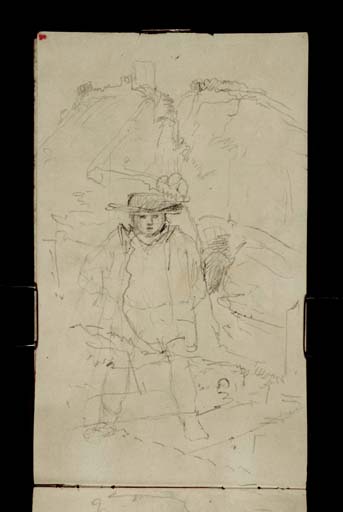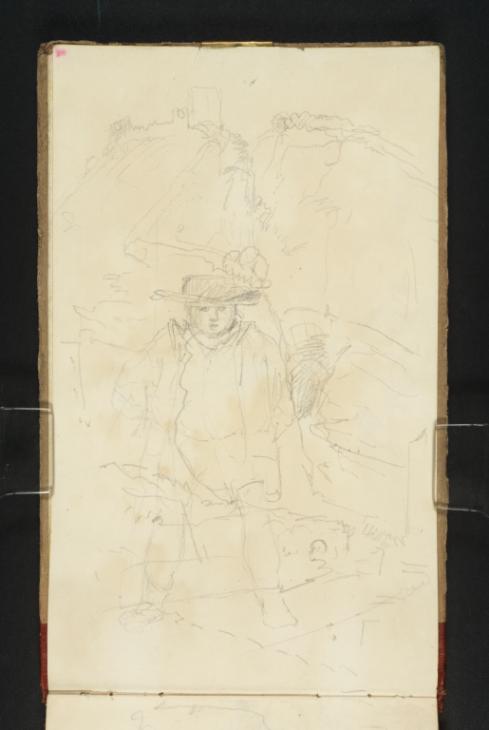Joseph Mallord William Turner Study of a Man, Perhaps a Farmer; Peveril Castle and the Entrance to Peak Cavern from the North-West ?1831
Image 1 of 2
-
 Joseph Mallord William Turner, Study of a Man, Perhaps a Farmer; Peveril Castle and the Entrance to Peak Cavern from the North-West ?1831
Joseph Mallord William Turner, Study of a Man, Perhaps a Farmer; Peveril Castle and the Entrance to Peak Cavern from the North-West ?1831 -
 Joseph Mallord William Turner, Study of a Man, Perhaps a Farmer; Peveril Castle and the Entrance to Peak Cavern from the North-West ?1831 (Enhanced image)Enhanced image
Joseph Mallord William Turner, Study of a Man, Perhaps a Farmer; Peveril Castle and the Entrance to Peak Cavern from the North-West ?1831 (Enhanced image)Enhanced image
Joseph Mallord William Turner,
Study of a Man, Perhaps a Farmer; Peveril Castle and the Entrance to Peak Cavern from the North-West
?1831
Joseph Mallord William Turner 1775–1851
Folio 1 Verso:
Study of a Man, Perhaps a Farmer; Peveril Castle and the Entrance to Peak Cavern from the North-West ?1831
D22152
Turner Bequest CCXXXIX 1a
Turner Bequest CCXXXIX 1a
Pencil on white wove paper, 191 x 114 mm
Accepted by the nation as part of the Turner Bequest 1856
References
1909
A.J. Finberg, A Complete Inventory of the Drawings of the Turner Bequest, London 1909, vol.II, p.733, CCXXXIX 1a, as ‘Figure of countryman, also views of road, bridge, hill, &c. (drawn over man’s figure)’.
There are at least three sketches here, made with the page turned vertically. Towards the lower left is a study of a stocky man in a shallow, wide-brimmed hat and short coat, standing with his feet placed firmly; he is probably a ‘countryman’, as Finberg suggested,1 and is perhaps a farmer2 encountered in the Midlands. The figure study overlaps with the landscape sketches, although it is a moot point as to which was made first. For other figure studies in this sketchbook, see the entry for inside the front cover (D41053). The subject of the main sketch was tentatively identified as ‘Peveril Castle?’, Derbyshire, by A.J. Finberg (died 1939) and the watercolour and Turner scholar C.F. Bell (died 1966) in undated manuscript notes in copies of Finberg’s 1909 Inventory,3 and confirmed by Ian Warrell as a view from the north-west, with the gorge leading to Peak Cavern below, south of Castleton village; across the middle of the page is a view of the entrance to Peak Cavern itself.4
A Norman castle on the site is mentioned in the Domesday survey (1086), and the keep was added by Henry II in 1176 at the highest corner of the roughly triangular enclosure. By Turner’s time it was in much the same ruinous state as seen today; it is now in the care of English Heritage.5 Turner presumably made his extensive survey of the neighbourhood in preparation for potential illustrations to a new edition of Sir Walter Scott’s novel Peveril of the Peak (first published in 1823) but this subject was not developed (see the sketchbook’s Introduction). Just below on the west side is the mouth of the extensive Peak Cavern, the largest natural cave entrance in Britain, which once housed a community of rope-makers supporting the local lead-mining industry.6 Nearby, a little west of Castleton, are Blue John Cavern, Treak Cavern and Speedwell Cavern. The slight, rough quality of Turner’s cave sketches is presumably owing to the difficulties of working in low light in confined spaces.
There are extensive further views of Peveril Castle, Castleton and the exterior and interior of Peak Cavern or other nearby Peak District caves inside the front cover (D41053), on folios 1 recto, 2 recto, 7 verso, 9 verso, 10 recto, 19 recto, 19 verso, 20 recto, 20 verso, 21 recto, 21 verso–22 recto, 22 verso, 24 recto, 32 verso, 33 recto and verso, 34 recto and verso, 35 verso, 36 recto and verso, 37 recto and verso, 38 recto and verso, 39 recto and verso, 40 recto and verso, 41 recto and 41 verso, 42 recto and verso, 43 recto, 45 verso, 46 verso, 47 recto and verso, 48 recto and verso, 52 recto, 55 verso and 59 verso (D22151, D22153, D22162, D22166, D22167, D22183–D22190, D22192, D22209–D22213, D22215–D22230, D22234, D22236–D22240, D22245, D22252, D22260), and on folios 79 verso, 83 verso (Speedwell Cavern), 84 verso, 85 recto and verso, 86 recto, 91 recto and 92 recto (D22296, D22304, D22306–D22309, D22319, D22321; Turner Bequest CCXXXIX 78a, 82a, 83a, 84, 84a, 85, 90, 91).
Matthew Imms
April 2014
A.J. Finberg, undated MS notes in a copy of Finberg 1909, Tate Britain Prints and Drawings Room, vol.II, p.733; C.F. Bell, undated MS notes in another copy at the same location, vol.II, p.733.
See ‘Peveril Castle’, English Heritage, accessed 7 April 2014, http://www.english-heritage.org.uk/daysout/properties/peveril-castle/ .
See ‘Inside Peak Cavern’, Peak Cavern, accessed 7 April 2014, http://peakcavern.co.uk/general/peak-cavern-intro/ .
How to cite
Matthew Imms, ‘Study of a Man, Perhaps a Farmer; Peveril Castle and the Entrance to Peak Cavern from the North-West ?1831 by Joseph Mallord William Turner’, catalogue entry, April 2014, in David Blayney Brown (ed.), J.M.W. Turner: Sketchbooks, Drawings and Watercolours, Tate Research Publication, September 2014, https://www

